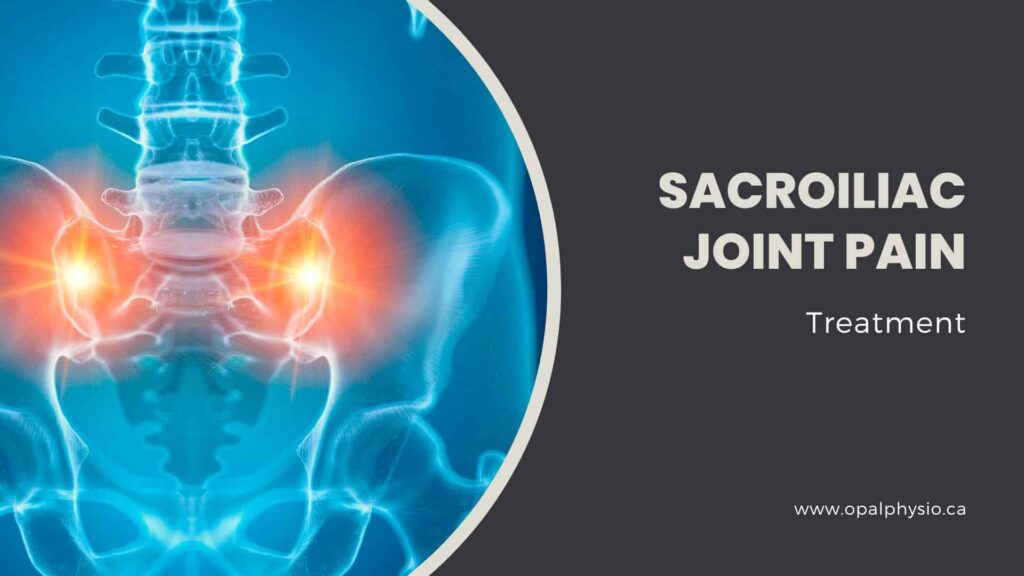Sacroiliac Joint Pain (SI Joint Pain)
SI Joint Pain Physiotherapy Treatment
Our expert team at Opal provides comprehensive sacroiliac joint pain physiotherapy treatments ensuring you receive the best possible care and support. We understand that sacroiliac joint pain can be debilitating, affecting your daily life activities. Our dedicated physiotherapists are here to help you regain mobility and reduce pain.

What is sacroiliac joint pain(SIJ)?
Sacroiliac joint pain is the pain in the joint where the sacrum and pelvis connect. The SIJ, or sacroiliac joint, is located in the pelvis and connects the sacrum and the ilium bones. Its surrounding ligaments provide stability and movement while absorbing excessive pressure and shock between the spine and the lower body.
Sacroiliac joint pain is a painful condition caused by injury, inflammation or disease. SI Joint pain is sometimes misdiagnosed as the groin, hip or lower back pain.
Common causes of SIJ pain:
Trauma or injury: A fall or blow to the lower back or pelvis can cause SI joint pain.
Pregnancy: During pregnancy, hormones are released to loosen the ligaments and joints in preparation for childbirth, which can cause SIJ pain.
Arthritis: Osteoarthritis, rheumatoid arthritis, or psoriatic arthritis can cause inflammation and pain in the SIJ.
Ankylosing spondylitis: A chronic inflammatory disease that can affect the SIJ and spine, causing pain and stiffness.
Leg length discrepancy: When one leg is shorter, it can cause an uneven weight distribution on the SIJ, leading to pain.
Repetitive motions: Activities that involve repetitive twisting or bending, such as running or dancing, can strain the SIJ and cause pain.
Poor posture: Poor or altered posture can place excessive stress on the SIJ and cause pain.
Degenerative disc disease: As the discs between the vertebrae in the spine wear down with age, the SIJ may experience more pressure and strain, leading to pain.
Infection: An SIJ or nearby bone infection can cause pain and inflammation.
Tumours: Although rare, tumours in or around the SIJ can cause pain and discomfort.
Symptoms of sacroiliac joint pain
When the sacroiliac joint becomes inflamed or irritated, it can cause
The underlying cause of sacroiliac joint dysfunction can be treated using a variety of approaches, and physiotherapy treatment is the first-line approach to this condition.
Physiotherapy can help relieve symptoms and improve function by:

SI joint pain physiotherapy treatment at Opal Physio
Assessment: Our experienced physiotherapists will thoroughly evaluate the underlying cause of your sacroiliac joint pain. This includes a detailed medical history, physical examination, and functional assessments to customize your pelvic floor physio treatment plan.
Individual treatment plans: We understand that every individual is unique, and so is their pain. At Opal, our therapists ensure that your treatment plan addresses your specific needs, goals, and the cause of your sacroiliac joint pain.
Hands-on approach: Our skilled physiotherapists utilize various hands-on techniques, such as joint mobilization, soft tissue mobilization, and myofascial release, to relieve pain, improve joint mobility, and enhance overall functionality.
Exercise prescriptions: An integral part of our sacroiliac joint pain physiotherapy treatment involves prescribing specific exercises to improve strength, flexibility, and stability in the affected area. Our physiotherapists will guide you through an exercise program to help you regain your normal function.
Postural education and ergonomics: We educate our patients on proper posture and body mechanics to prevent future sacroiliac joint pain and maintain long-term health.
Modalities: Depending on your needs and treatment goals, our physiotherapists may incorporate different therapeutic modalities, such as ultrasound, electrical stimulation, laser and heat/cold therapy, to alleviate pain and promote healing.
Braces: Your physiotherapist may recommend an SIJ belt to help provide support and stability during daily activities as you continue working on gaining strength and flexibility.
Home exercise program: they are designed by your therapist to address the impairments, manage and reduce symptoms as part of your recovery
Contact us today so that we can help your SIJ pain.
At OpalPhysio Clinic in Langley, our friendly and knowledgeable team is committed to providing the highest quality care for your sacroiliac joint pain. We work closely with you to develop an effective treatment plan and support you throughout your journey to recovery.
Take a step towards a pain-free life by contacting Opal Physio Clinic today. Call us or contact us to book an appointment for comprehensive sacroiliac joint pain physiotherapy treatment in Langley. Together, we will help you regain mobility, confidence, and overall wellness.
